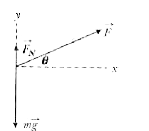In Fig. 5-29, a block of mass m = 5.00 kg is pulled along a horizonttal frictionless floor by a cord that exerts a force of magnitude F = 12.0 at an angle θ=25.0∘.

Figure 5-29 A block is pulled along a horizontal floor.
(a) What is the magnitude of the block's acceleration?
The free-body diagram (not to scale) for the block is shown in Fig. 5-30. →FN is the normal force exerted by the floor and m→g is the force of gravity.
Calculation: The x component of Newton.s second law is Fcosθ=ma, where m is the mass of the block and a is the x component of its acceleration. We obtain
a=Fcosθm=(12.0 N)cos25.0∘5.00 kg=2.18m/s2.
This is its acceleration provided it remains in contact with the floor. Assuming it does, we find the value of FN (and if FN is positive, then the assumption is true but if FN is negative then the block leaves the floor). The y component of Newton.s second law becomes
FN+Fsinθ−mg=0,
so
FN=mg−Fsinθ
=(5.00 kg)(9.80 m/s2)−(12.0 N)sin25.0∘
=43.9 N.
Hence, the block remains on the floor and its acceleration is a=2.18 m/s2.

Topper's Solved these Questions
- FORCE AND MOTION - I BOOK - RESNICK AND HALLIDAYCHAPTER - FORCE AND MOTION - I EXERCISE - CHECKPOINT
5 Videos
- FORCE AND MOTION - I BOOK - RESNICK AND HALLIDAYCHAPTER - FORCE AND MOTION - I EXERCISE - PROBLEMS
52 Videos
- FLUIDSBOOK - RESNICK AND HALLIDAYCHAPTER - FLUIDSEXERCISE - PRACTICE QUESTIONS (Integer Type )
5 Videos
- FORCE AND MOTION-IIBOOK - RESNICK AND HALLIDAYCHAPTER - FORCE AND MOTION-IIEXERCISE - PRACTICE QUESTIONS (Integer Type)
1 Videos
Similar Questions
A block of mass M is pulled along a horizontal frictionless surface by a rope of mass m. If a force P is applied at the free end of the rope, the force exerted by the rope on the block will be
View SolutionFigure shows a 5.00 kg block being pulled along a frictionless floor by a cord that applies a force of constant magnitude 15.0 N but with an angle θ(t)that varies with time. When angle θ=25.0∘, at what rate is the acceleration of the block changing if (a) θ(t)=(2.00×10−2deg/s)t and (b) θ(t)=−(2.00×10−2deg/s)t ?

View Solution
Knowledge Check
A block of mass M is pulled along a horizontal frictionless surface by a rope of mass m. If a force F is applied at one end of the rope, the force which the rope exerts on the block is :
AF/(M+m)BFCFM(m+M)D0A block of mass M is pulled along a horizontal frictionless surface by a rope of mass m. If a force P is applied at the free end of the rope, the force exerted by the rope on the block is
APm(M+m)BPm(M−m)CPDPM(M+m)A block of mass M is pulled along a horizontal frictionless surface by a rope of mass m. If a force P is applied at the free end of the rope, the force exerted by the rope on the block is
A(a) PmM+mB(b) PmM−mC(c) PD(d) PMM+m
A block of mass M is pulled along a horizontal frictionless surface by a rope of mass m. If a force F is applied at one end of the rope. Find the force which the rope exerts on the block.
View SolutionA block of mass M is pulled along a horizontal frictionless surface by a rope of mass m. If a force P is applied at the free end of the rope , the force exerted by the rope on the block .
View Solution
A block of mass 2 m is pulled along a horizontal frictionless surface by a rope of mass m as shown in the figure given above. What force is exerted by the rope on the block ?
View SolutionA block of mass 2 m is pulled along a horizontal frictionless surface by a rope of mass m as shown in the figure given. What force is exerted by the rope on the block ?

View SolutionA block of mass m is placed on a horizontla surface. If the block is pulled by applying a force of magnitude F=5mg at an angle θ=37∘, with horizontal as shown in fig. find the acceleration of the block at the given instant.

View Solution
